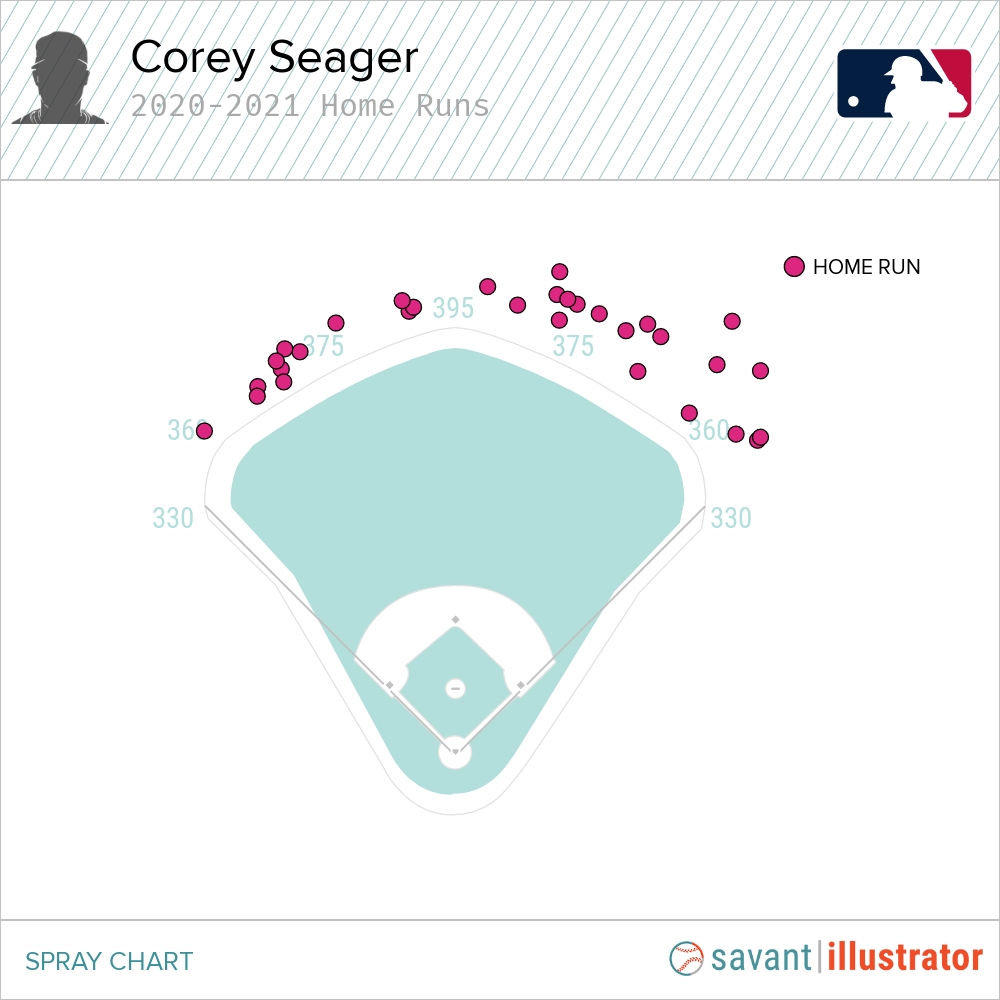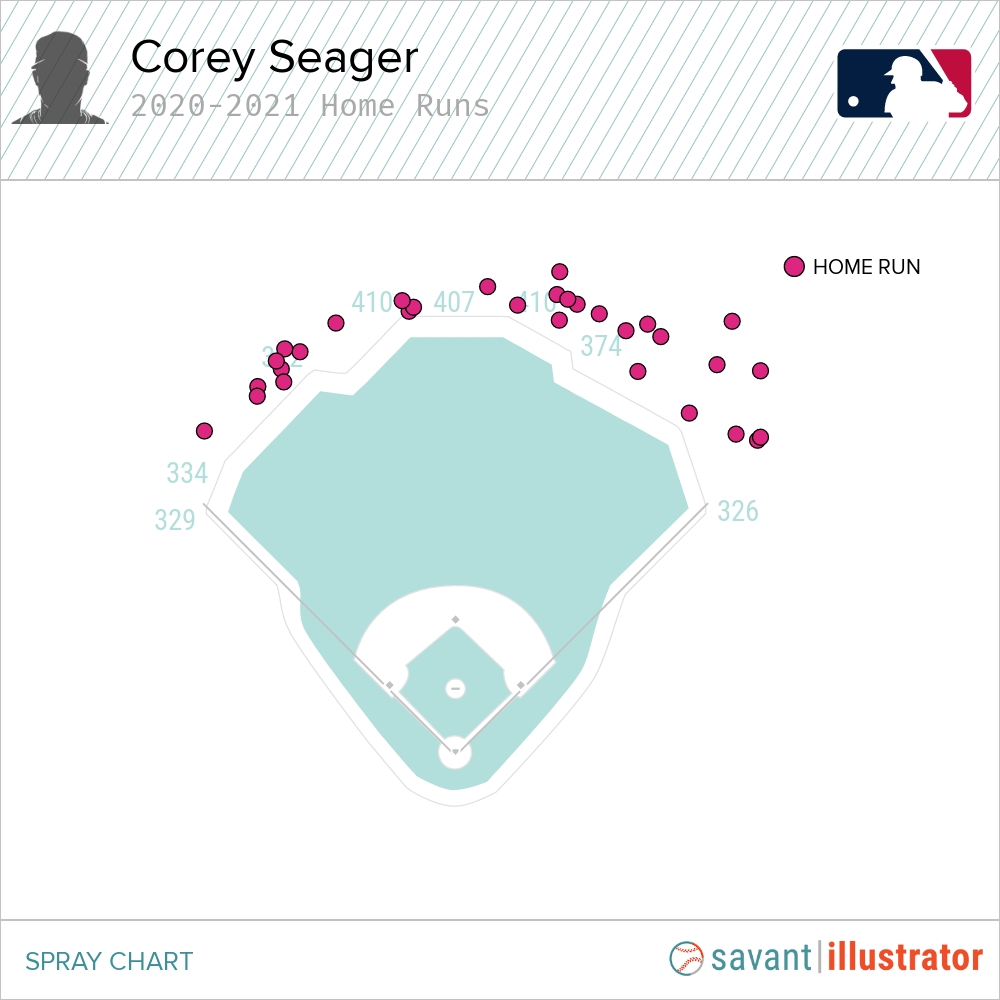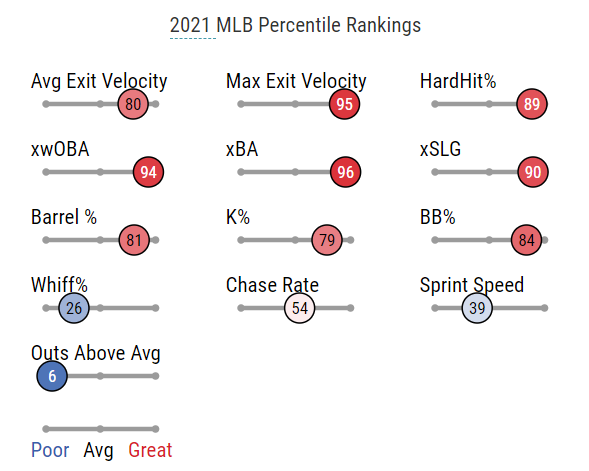When Corey Seager’s name was read with the 18th overall pick of the MLB Amateur Draft in 2012, his selection (and signing value) came with appropriately lofty expectations attached to them. The Dodgers were placing a lot of faith in the teenage phenom, who wowed scouts with his strong contact skills and hair-raising power potential at the plate. Over the course of the next decade, Seager rewarded that faith by somehow managing to overdeliver on those expectations, first with a unanimous Rookie of the Year season in 2016, and years later by playing the pivotal role in the Dodgers’ first World Series championship since 1988. In between were seasons where Seager cemented himself as one of the top offensive talents in baseball, and one of the game’s premier shortstops.
And now, Corey Seager is a Texas Ranger.
He’s ours.
We’ve signed SS @coreyseager_5 to a 10-year contract. pic.twitter.com/MEdUCvfESA
— Texas Rangers (@Rangers) December 1, 2021
This might take some getting used to.
On December 1, Seager signed a record-breaking contract to become the face of the Rangers franchise over the next decade, guaranteeing himself $325,000,000 in the process. The deal gives Seager security over the next ten seasons as he enters the second half of his career, and it immediately gives the Rangers a star shortstop and franchise player to build around as the team prepares for another run at contention in the coming years. With that, let’s take a closer look at the player the Rangers just hitched their (mostly proverbial) horse to for the next decade, as well as analyze the signing’s implications for fantasy baseball in 2022.
Ups and Downs
After Corey Seager was drafted in 2012, he proceeded to blaze through the minors in just three years and made his debut in a promising cup of coffee at the end of the 2015 MLB season. The stage was set for Seager to make his proper debut in 2016, when he took the league by storm in his first full season, slashing .308/.365/.512 with 26 home runs and a 136 wRC+ on his way to posting 6.9 fWAR. It was a dramatic coming-out party for the 22-year-old, who took home unanimous Rookie of the Year honors and even finished third in NL MVP voting. Seager solidified his status as a premier MLB shortstop in the years that followed, building on his impressive rookie season with another All-Star performance in 2017, when he put up 6.0 fWAR with a 127 wRC+. When UCL and hip injuries prematurely ended Seager’s 2018, he bounced back the following year and finished with a .272/.335/.483 line and a 112 wRC+ in 2019. And of course, in 2020, Seager flexed a largely clean bill of health on his way to a World Series MVP award, posting a .943 OPS in 52 regular-season games in the abbreviated campaign.
Seager’s 2021 was once again marred by injury—an errant fastball from Marlins southpaw Ross Detwiler fractured the shortstop’s right hand in May and caused him to miss 65 games. However, when he was on the field, Seager once again headlined a star-studded Dodgers lineup, leading the team with a .915 OPS in 95 games. At this point, a clear narrative had formed surrounding Seager: he was one of the best shortstops in baseball, provided he could stay on the field.
And while Seager has missed the majority of his time due to unrelated injuries, he has still only eclipsed 100 games in a season three times in his career. From 2020-2021, Seager played in just 147 of 222 possible games, or around 66% of his team’s contests. That said, it’s important to recognize his aforementioned broken hand in 2021 was a freak accident, which carries little predictive value going forward. With any luck, the Rangers are banking on the most severe of Seager’s injuries being behind him as they build around him in the coming seasons.
Contract Breakdown
Seager’s contract guarantees him $325,000,000 over the next ten years and secures the slugger through 2031, his age-37 season. The front-loaded structure of the contract will allow the Rangers some flexibility in the later years of the deal, though the $32,500,000 average annual value (AAV) of the contract remains the largest on the team’s payroll by a significant margin. The deal shattered franchise records and included a $5,000,000 signing bonus, as well as a limited no-trade clause cementing Seager’s coming tenure in Arlington.
The Rangers are paying upfront for Seager’s prime years under this structure, and have placed a significant wager on their belief that Seager’s offensive talents will age well into the twilight of his career. With contact and slugging tools among the best at his position, Seager’s bat is expected to anchor the Rangers lineup for the better part of the next decade.
A Texas-Sized Impact
That Rangers lineup is now expected to pack a vicious punch with Seager at the top of it, alongside his fellow free-agent signee Marcus Semien, who will line up opposite Seager at second base. Nate Lowe and Adolis García are also returning to provide some pop in the middle of the order, with both projected by Steamer to hit more than 20 home runs in 2022. Nick Solak and promising third base prospect Josh Jung are expected to round out the lineup, along with the catching platoon of Jonah Heim and Jose Trevino. Newly-signed veteran Kole Calhoun and the versatile Isiah Kiner-Falefa will also be in the mix, providing needed depth off of the bench. Ultimately, the bottom third of the Rangers lineup could prove shaky down the stretch, but the acquisitions of Seager and Semien immediately give them the most offensively talented middle infield in baseball in advance of any additional free agent signings.
While Seager is expected to be the focal point of the Rangers lineups for years to come, his long-term role in the field is less certain. For the immediate future, he will return to his natural position at shortstop, which he manned for the Dodgers for 5182 major league innings. It was in Los Angeles that Seager initially developed his close relationship with Rangers manager Chris Woodward, who was the Dodgers’ infield coach from 2016-2018.
A persisting theme of Corey Seager’s career to this point has been the ever-present whispers suggesting an eventual move to third base, where his 6’4″ frame is better suited to the duties of the hot corner. And while that option may remain on the table for the later years of his career, in the present the Rangers don’t have any highly anticipated shortstop prospects breathing down Seager’s neck, making it likely he’ll remain at the position for the foreseeable future. Additionally, by entering the American League, Seager is also now eligible to serve as the designated hitter as needed in order to maintain his health over the course of the 162-game season. The dynamic Semien can also slide back over to shortstop (his primary position) at a future point if necessary.
In the field, Seager grades out as below average defensively at shortstop by most metrics, and posted -6 outs above average (OAA) in 2021 that was 28th best among qualified shortstops according to Baseball Savant data. Something to keep an eye on, however, is the frequency of defensive shifts employed by the Rangers infield in 2022. The Dodgers shifted more than any other team in baseball last season, rolling out shifted alignments on 53.6% of plate appearances. The Rangers, meanwhile, only shifted 30.3% of the time in 2021, ranking 17th in MLB.
Relevance for Fantasy
Corey Seager’s status as a premier slugging shortstop is nothing to be understated. At the plate, he poses a wicked combination of both contact and power and provides a high floor for both in fantasy. Assuming health, Seager is a safe bet for a .290 batting average and 20-25 home runs. Where Seager takes the largest hit to his fantasy value is his complete lack of stolen base upside, having swiped just a dozen bags to date in his Major League career. This limiting factor is what holds Seager back from joining the upper echelon of first-round fantasy shortstops like Trea Turner and Fernando Tatis Jr., despite his undeniable prowess in the batter’s box.
Seager also exhibits a fair amount of plate discipline for all of his reputation of being an aggressive first-pitch swinger. His walk rate climbed to a career-high of 11.7% in 2021, and his career walk rate of 9.4% remains above league average. His chase rate on pitches outside of the strike zone was also a reasonable 26.9% last year, yet he still attacked pitchers bold enough to pitch to him, swinging at pitches in the zone at an 81.5% rate in 2021. It was a measured aggression, one that made Seager a dangerous matchup regardless of who was on the mound.
Moving from the offensive juggernaut of the Dodgers lineup to that of the still-potent Rangers does have its drawbacks, however, namely when it comes to accruing counting stats. Seager will lose the benefits of All-Star talents like Mookie Betts, Trea Turner, Justin Turner, and Max Muncy surrounding him in the lineup, which will negatively impact Seager’s RBI and run-scoring upside. That said, the Rangers lineup is nothing to scoff at either, so Seager will still rack up his fair share of counting stats relative to the rest of the league, even if his upside in those categories is affected.
The move to Globe Life Field also places Seager in a new offensive environment, one that is not entirely unfamiliar to the veteran shortstop. As some may remember, Seager was first introduced to the Rangers’ new stadium during the 2020 postseason when the Dodgers played 16 consecutive games there during their playoff run as part of MLB’s COVID-19 bubble. Following his MVP performances in the 2020 NLCS and World Series, Seager actually briefly held the all-time record for home runs at Globe Life Field with eight. Now, Seager makes his return to the stadium where he lived out one of the greatest postseasons by a shortstop in baseball history.
Corey Seager rakes at Globe Life Field.
He hit 7 homers there in the 2020 postseason ⬇️ pic.twitter.com/RHT1UUrGhj
— MLB Vault (@MLBVault) November 29, 2021
In its brief existence, Globe Life Field has played roughly in accordance with its cavernous dimensions—a pitcher’s park that’s surrendered the 18th-most regular-season home runs since it opened in 2020. This stands in pale contrast with Dodger Stadium, which saw 238 balls leave the yard in the same period, a number second only to the infamous bandbox, Great American Ballpark in Cincinnati. This move has the potential to sap Seager’s home run numbers in the case he can’t rediscover his magical postseason connection with Globe Life Park. Seager’s home runs from 2020 and 2021 (together roughly equating to his last full MLB season) are mapped below, first on a diagram of Dodger Stadium, and then in his new home park in Texas.


Keep in mind, these visualizations don’t take wall height or environmental factors into account, but at least on a surface level, it looks promising that Seager’s power will largely translate to his new home ballpark. He may lose out on a few longballs throughout the season though, as expected home run by park data predicts four of Seager’s home runs would have come up just short had he played the entirety of his games at Globe Life Field in 2021. So while Seager’s move to Arlington will undoubtedly have an impact on his power numbers, its exact magnitude remains difficult to forecast. Although, Seager’s Statcast profile does make a strong argument on his behalf for 2022:

Of course, these snapshots of Seager’s offensive ability are just that—snapshots. They don’t paint the entire picture of a player and their capabilities, nor are they meant to. But on the other hand, just look at all of that red. Seager’s expected stats and peripheral information all back up that he is an elite hitter, and those skills will play in any park.
In short, Corey Seager’s outlook for 2022 remains largely similar to that of recent seasons. He’s one of a handful of hitters in MLB that can be consistently counted on for both elite average and slugging, and he provides them at a premium defensive position. While Seager may no longer be reaping the fantasy benefits of hitting in the stacked Dodgers lineup, the Rangers have the potential to be a very strong offense in 2022, and his outstanding bat will shine in any park. His fielding grades out as roughly below average, and he won’t steal any bases which places a cap on his fantasy value, but you’d be hard-pressed to find a player with a higher offensive floor at shortstop. If he can stay healthy, Corey Seager will enjoy a lengthy and productive career at the heart of Rangers teams for years to come.
Congratulations, Rangers fans. You got a good one.
Photo by Brian Rothmuller/Icon Sportswire | Adapted by Justin Paradis (@JustParaDesigns on Twitter)

